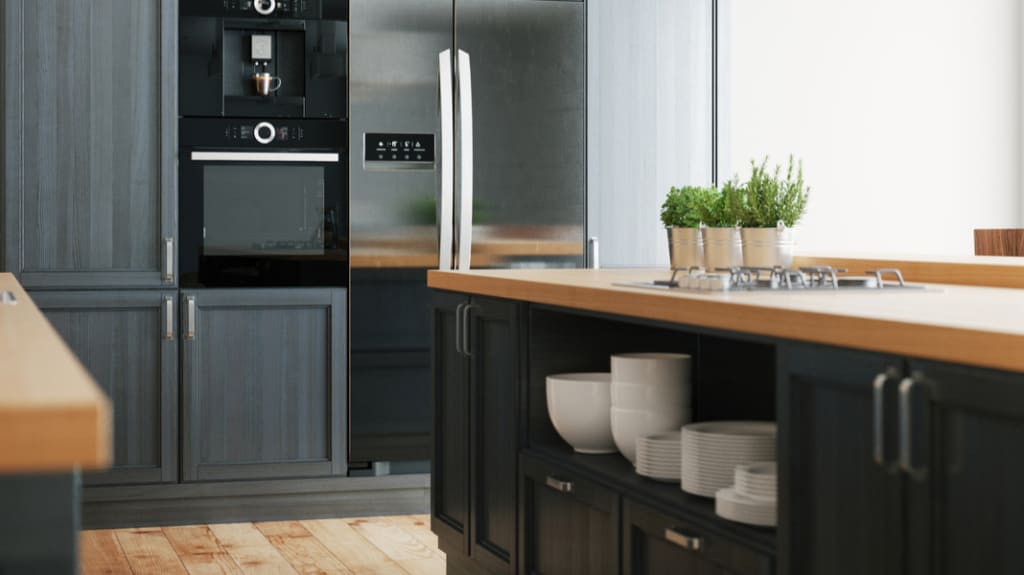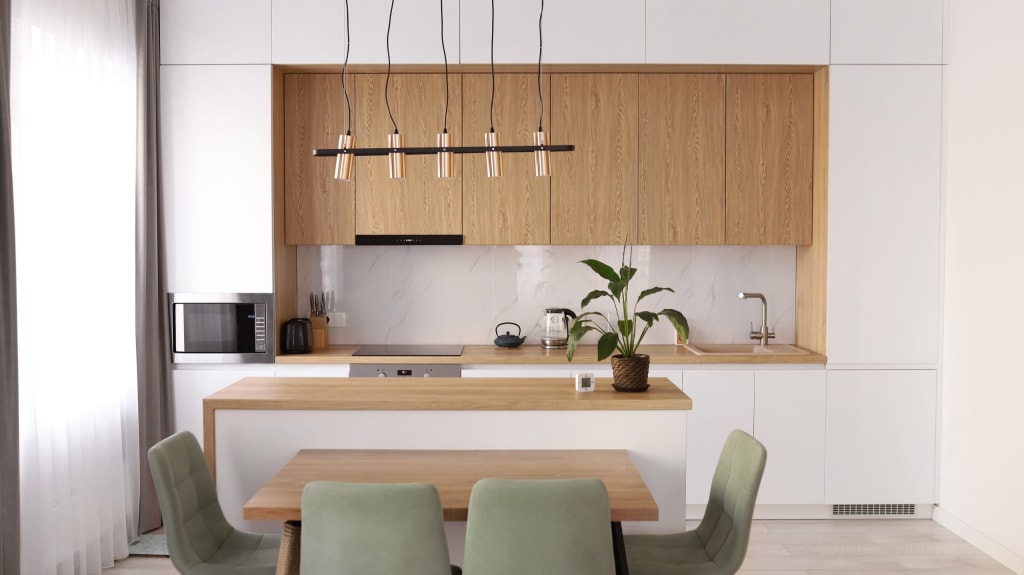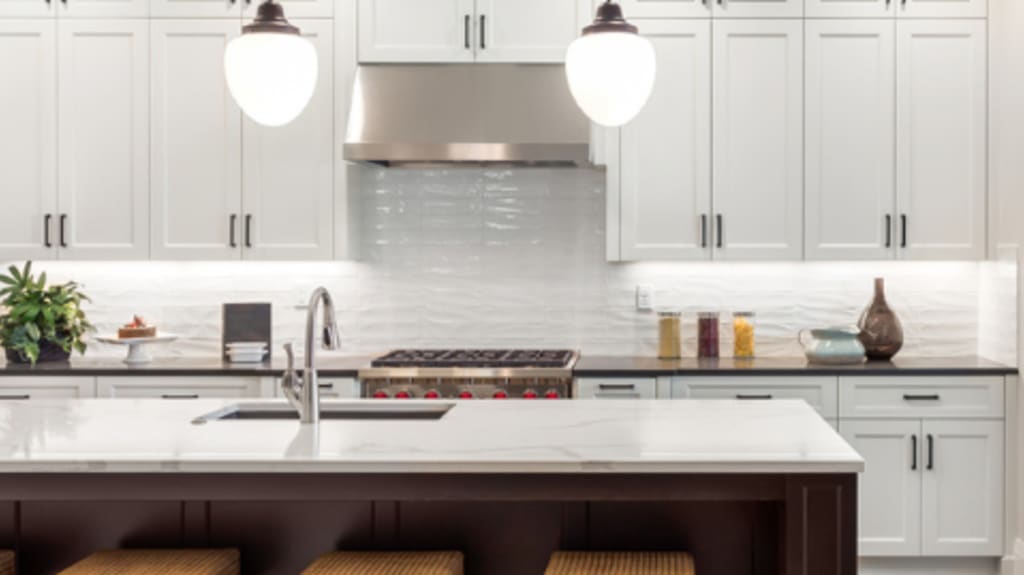Whether you’re looking to get more enjoyment from your home or are preparing to sell, remodeling your kitchen is exciting. And what better place to start than with your kitchen cabinets! But with so many types of kitchen cabinet materials available, getting started is confusing. Luckily, we’re here to break it all down for you.
Did you know that minor kitchen remodels, such as redoing your cabinets, have a major return on investment? In 2020, our renovation experts found that they could bring back 75% to 100% of what you invest. So, with that in mind, let’s talk about what kitchen cabinet material is best for your space.
What type of material is best for kitchen cabinets?
The best kitchen cabinet materials are the ones that fit your aesthetic, needs, and budget. For instance, if you’re going for an industrial look, you may select stainless steel cabinetry. French provincial? Consider plywood painted white with glass. While most cabinetry is made from wood or wood alternatives, other options may better suit your needs.
How much do kitchen cabinets cost?
When you’re looking for new kitchen cabinet materials, cost is an important factor to consider. How much you’ll spend depends on two main factors: type of material and level of customization. In the table below, we’ve listed the average cost associated with various cabinet types. These averages are based on a simple L-shaped kitchen without an island.
Cabinet type | Average cost (including materials, labour, installation) |
Hardwood | $18,000 – $26,500 |
Medium density fibreboard (MDF) | $19,000 – $24,000 |
Wood veneer | $14,500 – $18,000 |
Laminate | $11,000 – $15,500 |
Melamine | $12,000 – $18,000 |
Velour Touch | $15,500 – $21,500 |
Glossy similaque | $15,500 – $23,000 |
Polyester | $12,000 – $18,000 |
Polyvinyl chloride (PVC) | $14,500 – $19,000 |
Acrylic | $16,500 – $21,500 |
Glass | It depends on the type of cabinet. Material cost + $90 – $120 per door |
Cabinet resurfacing | $6,000 – $9,500 |
What materials are used to make kitchen cabinets?
When it comes time to choose the kitchen cabinet materials that are right for you, you’ll be spoiled for choice. From wood options to metal, glass, and more, there’s something to suit everyone’s style and budget. While cost is certainly a factor, there are some other pros and cons to consider with each material as well.
Wooden cabinets
Out of all quality kitchen cabinet materials, wood is one of the best choices available. Although expensive, wooden cabinets are durable, long-lasting, and always in style. As an added bonus, wood cabinets are easy to paint so you can update the look whenever you feel like it.

Hardwood cabinets
Hardwood is easily one of the most popular kitchen cabinet materials out there. Since it comes from trees, each panel can vary slightly as individual trees have their own textures, colours, and grain patterns. You can also paint or stain them! It’s important to remember that some hardwood types, like hickory or maple, are more durable than softwood species like walnut and mahogany.
Pros:
Timeless and durable
Available in a wide range of styles and colours
Easy to repaint or restain later on
Unique textures and grain patterns
Easy to customize
Cons:
Expensive compared to other kitchen cabinet materials
Humidity can cause wood to expand and contract
May require special cleaning products
Plywood cabinets
Plywood is another popular kitchen cabinet material, offering a slew of benefits. If you love the look of wood cabinets but don’t want to spend a fortune on hardwood, plywood is an excellent alternative.
To explain it simply, plywood is made using thin layers of logs that have been soaked in water. After the thin wood layers are dried, they are compressed together and covered with a veneer to create plywood. Plywood is one of the best kitchen cabinet materials because it’s durable and resists moisture better than comparable materials.
Pros:
Lightweight and easy to work with
Durable and hold screws easily
More resistant to water than comparable kitchen cabinet materials
Cons:
Similar to MDF but more expensive
May be tough to get a smooth finished edge on plywood
Composite cabinets
Composite cabinets are a cost-effective solution for homeowners on a budget. They’re often covered with a hardwood veneer to give them a stylish look. Underneath that veneer, you’ll typically find fibreboard or particleboard.

Medium density fibreboard cabinets (MDF)
This cost-effective kitchen cabinet material can be found in most big box furniture stores and IKEA! It’s reasonably strong, smooth, and easy to customize. Quality-wise, it’s between plywood and particleboard.
Pros:
Inexpensive
Smoother finish than regular particleboard
Highly customizable
Cons:
When exposed to moisture, MDF can warp easily
Dense and heavy, making it harder to hold screws
Particleboard (or low density fibreboard) cabinets
This kitchen cabinet material is in the same family as fibreboard but is low density rather than medium density. It’s usually finished with a layer of laminate or wood veneer. It’s another common kitchen cabinet material at IKEA.
Pros:
An inexpensive, easily accessible option
Lightweight
Cons:
Most susceptible to damage caused by moisture
Wood veneer cabinets
Veneers are slices or sheets of solid wood pasted onto composite substrate (makes them similar to laminates). They reflect the beauty and grain of natural wood without the cost of solid wood cabinets.
Pros:
A budget-friendly alternative that still offers the wood cabinet look
Cons:
When installed incorrectly, the veneer will start to peel off
Laminate cabinets
Laminate is similar to wood veneer in that it’s used to cover kitchen cabinet doors; it’s not used for interiors.
Pros:
Easy to clean with simple soap and water
A budget-friendly option
Cons:
Difficult to repair scratches and chips
Thermofoil cabinets
To create thermofoil cabinets, a thin layer of foil-like material is heated and then vacuum sealed onto wood or MDF. These types of cabinets are usually pretty simple in terms of design.
Pros:
Available in a vast variety of styles and colours
Budget-friendly
Cons:
Susceptible to peeling over time
Thermofoil can only cover 5 sides of your cabinet, meaning the backside of your cabinet door will not match
Resin cabinets

Resin cabinets are typically made of an inexpensive base (MDF, plastic, or paper) and then covered with an outer layer like a polyester film.
Melamine cabinets
Melamine is technically a laminate product, but it costs less since it’s made using paper and resin. One of the most affordable materials on the market.
Pros:
Comparable to but more affordable than laminate cabinets
Available in a wide array of colours
Easy to maintain
Imitates wooden cabinets successfully
Cons:
Inexpensive material is more susceptible to minor damages
Limited style options available
Scratches are difficult to retouch
Polyester cabinets
Polyester cabinets are made with a compound of melamine and pine fibre covered with a polyester film. It’s a low price but more sophisticated than melamine.
Pros:
Holds up better against scratches than melamine
You can choose from various colours and imitation wood
Cons:
Scratches can be difficult to retouch
PVC cabinets
Polyvinyl chloride (PVC) is made up of sheets of plastic composite. It’s gained popularity in modular kitchens. There are two common types: hollow boards and foam boards. Hollow boards, as the name suggests, are hollow and lightweight. Foam boards are heavier, sturdier, and overall the better choice for kitchens.
Pros:
Easy to install
Moisture-resistant
Doesn’t require an expensive finish to look appealing
Cons:
May droop over time
Colour and design selection are limited
Prone to damage and scratches
Luxury cabinets
Some homeowners aim for warm, comforting, and functional cabinetry, while others strive for luxury. If you’re looking to make a statement, check out these kitchen cabinet materials.
Metal cabinets
Some modern kitchens opt for more unique materials, like stainless steel, to achieve their aesthetic. It’s preferred in professional kitchens because it’s easy to clean and maintain.
Metal cabinets may look and feel luxurious, but they can be a budget-friendly choice, especially when you choose aluminum. Aluminum is a common, cost-effective kitchen cabinet material that comes with numerous advantages.
Pros:
Easy to clean
Durable and flexible
Recyclable and can be reused indefinitely
Cons:
Not everyone likes the aesthetic of metal cabinets
Glass cabinets
One pane, several panes, frosted, clear, there are lots of options for glass kitchen cabinets. Feel free to mix and match materials to find a kitchen cabinet design that suits your personality.
Pros:
Glass cabinets make your kitchen feel bigger
Can have your dishware and pantry items on display
Cons:
Fragile and susceptible to cracking and breaking
Can be an expensive choice
Cabinet resurfacing
If your cabinets are in good condition, but your doors are damaged, discoloured, or faded, you should consider cabinet resurfacing. Lacquer finish is also an option if resurfacing.
Pros:
Easier, faster, and cheaper than installing all-new cabinets
A small update that has a big impact
Cons:
Usually only a temporary solution
Spice up your kitchen
When it’s time to update your cabinets, your options for kitchen cabinet materials are nearly endless. Whether you want to save as much money as possible or want to completely elevate your kitchen with a unique design, there’s a material that will perfectly suit your needs. For that extra bit of luxury, consider getting a professional cabinet finish done.
Are you ready to take the next step with your kitchen renovation? Then check out our renovation checklist, some cost-saving tips, and these kitchen renovation must-haves. And don’t forget to read our article to learn more about realistic kitchen renovation costs.
By: Amber Van Wort
Amber is a freelance content writer with a degree in journalism from Durham College. Amber’s work has been published in Narcity, Chicago Tribune, The Belleville Intelligencer, Best Reviews, and more. Her passions include food, travel, and real estate. When she’s not busy meeting her client’s expectations, you can find Amber in the kitchen, elbow-deep in a bag of flour.





